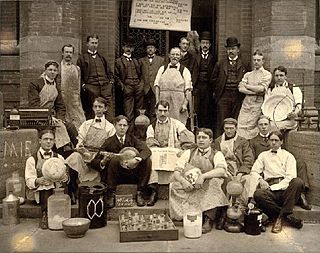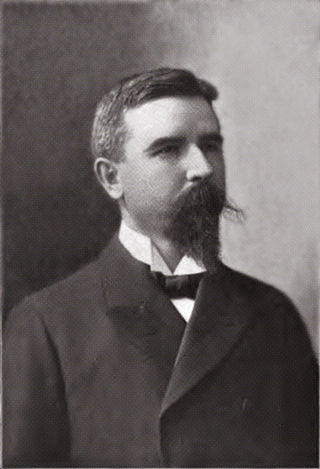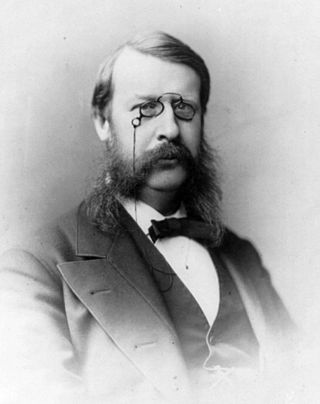
Frederick Augustus Porter Barnard was an American academic and educator who served as the 10th President of Columbia University. Born in Sheffield, Massachusetts, he graduated from Yale University in 1828 and served in a succession of academic appointments, including as Chancellor of the University of Mississippi from 1856 to 1861. He assumed office as President of Columbia University in 1864, where he presided over a series of improvements to the university until his death in 1889. He was also known as an author of academic texts.

Clarence Rivers King was an American geologist, mountaineer, and author. He was the first director of the United States Geological Survey from 1879 to 1881. Nominated by Republican President Rutherford B. Hayes, King was noted for his exploration of the Sierra Nevada mountain range.

Berzelius (BZ) is a secret society at Yale University in New Haven, Connecticut, United States. The society was established in 1848. It was named for the Swedish scientist Jöns Jakob Berzelius, considered one of the founding fathers of modern chemistry.

William Barton Rogers was an American geologist, physicist, and the founder and first president of the Massachusetts Institute of Technology (MIT).

Daniel Coit "D. C." Gilman was an American educator and academic. Gilman was instrumental in founding the Sheffield Scientific School at Yale College, and subsequently served as the second president of the University of California, Berkeley, as the first president of Johns Hopkins University, and as founding president of the Carnegie Institution.

John Torrey was an American botanist, chemist, and physician. Throughout much of his career, he was a teacher of chemistry, often at multiple universities, while he also pursued botanical work, focusing on the flora of North America. His most renowned works include studies of the New York flora, the Mexican Boundary, the Pacific railroad surveys, and the uncompleted Flora of North America.

Josiah Dwight Whitney was an American geologist, professor of geology at Harvard University, and chief of the California Geological Survey (1860–1874). Through his travels and studies in the principal mining regions of the United States, Whitney became the foremost authority of his day on the economic geology of the U.S. Mount Whitney, the highest point in the contiguous 48 United States, and the Whitney Glacier, the first confirmed glacier in the United States, on Mount Shasta, were both named after him by members of the Survey.

Sheffield Scientific School was founded in 1847 as a school of Yale College in New Haven, Connecticut, for instruction in science and engineering. Originally named the Yale Scientific School, it was renamed in 1861 in honor of Joseph E. Sheffield, a railroad executive. The school was incorporated in 1871. The Sheffield Scientific School helped establish the model for the transition of U.S. higher education from a classical model to one which incorporated both the sciences and the liberal arts. Following World War I, however, its curriculum gradually became completely integrated with Yale College. "The Sheff" ceased to function as a separate entity in 1956.

Addison Emery Verrill was an American invertebrate zoologist, museum curator and university professor.

Russell Henry Chittenden was an American physiological chemist. He conducted pioneering research in the biochemistry of digestion and nutrition.

John Addison Porter was an American professor of chemistry and physician. He is the namesake of the John Addison Porter Prize and was a founder of the Scroll and Key senior society of Yale University.

George Frederick Barker was an American physician and scientist.

William More Gabb was an American paleontologist.

Lafayette Benedict Mendel was an American biochemist known for his work in nutrition, with longtime collaborator Thomas B. Osborne, including the study of Vitamin A, Vitamin B, lysine and tryptophan.

Mount Brewer is on the Great Western Divide, a sub-range of the Sierra Nevada in California. It is located in Kings Canyon National Park,

Lardner Vanuxem was an American geologist. He was graduated at the Ecole des mines, Paris, in 1819. After his education, he became the Chair of Chemistry and Mineralogy at South Carolina College in Columbia, South Carolina. In 1826 he retired from the college and devoted his attention exclusively to geology as a profession. During that year he published in newspapers and in Robert Mills' "Statistics of South Carolina" report on the geology of the state.

Arnold Hague was an American geologist who did many geological surveys in the U.S., of which the best known was that for Yellowstone National Park. He also had assignments in China and Guatemala. He became a member of the United States Geological Survey in 1879 when it was first organized.

Samuel William Johnson was an American agricultural chemist. He promoted the movement to bring the sciences to the aid of American farmers through agricultural experiment stations and education in agricultural science.

William Petit Trowbridge was a mechanical engineer, military officer, and naturalist. He was one of the first mechanical engineers on the faculties of the University of Michigan, the Sheffield Scientific School of Yale, and the Columbia School of Mines. He had a brief military career after graduating from West Point and later served as Adjutant General for the State of Connecticut from 1873 to 1876. During his career as a surveyor on the American Pacific coast he collected thousands of animal specimens, several of which now bear his name.
Louis Valentine Pirsson was an American geologist and petrologist, best known for devising the CIPW norm for classifying igneous rocks. His 1915 "Textbook of Geology" was for decades the most widely used in the United States.



















